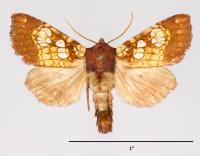Identification
Field Guide Descriptions: Covell (1984) Online Resources: MPG , BugGuide , iNaturalist , Google , BAMONA , GBIF , BOLD Technical Description, Adults: Forbes (1954)Technical Description, Immature Stages: Forbes (1954); Wagner et al. (2011)
Adult Markings: A medium-sized, brightly colored, and conspicuously spotted Papaipema. The basal and medial areas are largely yellow to ochre, with dark reddish-brown filling the subterminal and terminal areas, as well as the space between the orbicular and reniform spots and between the antemedian and basal lines; the lines themselves are this same shade of reddish-brown. The orbicular, claviform, and reniform are all very large, filled with white, with both the claviform and reniform subdivided into separate spots. The reniform, in particular, is distinctively large in this species, coming into contact at its top and bottom edges with the postmedian line (Forbes, 1954). The hindwings are tan to light buff.
Wingspan: 30 mm (Forbes, 1954)
Adult Structural Features: The valve of the male is illustrated but not described by Forbes (1954). Based on the illustration, however, the shape of the cucullus appears to be distinctive, being shorter and lacking the ventral prong found in many of the other species.
Adult ID Requirements: Identifiable from good quality photos of unworn specimens.
Immatures and Development: The larvae and their feeding behavior were described and illustrated by F.M. Jones (1908). They are borers in the rhizomes of Pitcher Plants, including both Sarracenia flava and purpurea in our area. Extensive mounds of orange frass are ejected, forming a mound above the exit hole, possibly helping keep the bore hole from flooding (Jones, 1908). Pupation occurs in the soil or sphagnum next to the rhizomes (Wagner et al., 2011). As is true for other Papaipema, eggs are laid in the fall and the young larvae probably remain above-ground until the following spring.
Larvae ID Requirements: Identifiable from good quality photos, especially where associated with known host plants.

 »
»

 »
»